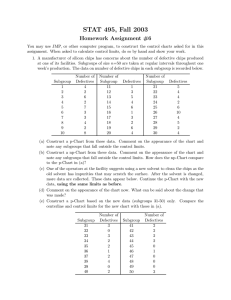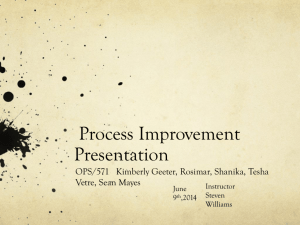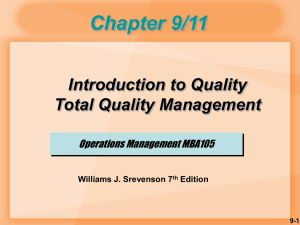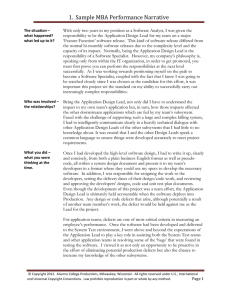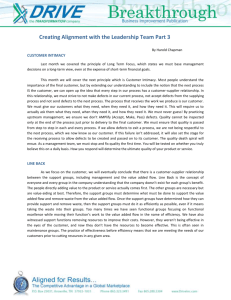Statistics 495, Applied Statistics for Industry I Name:__________________________ Site:____________________________
advertisement
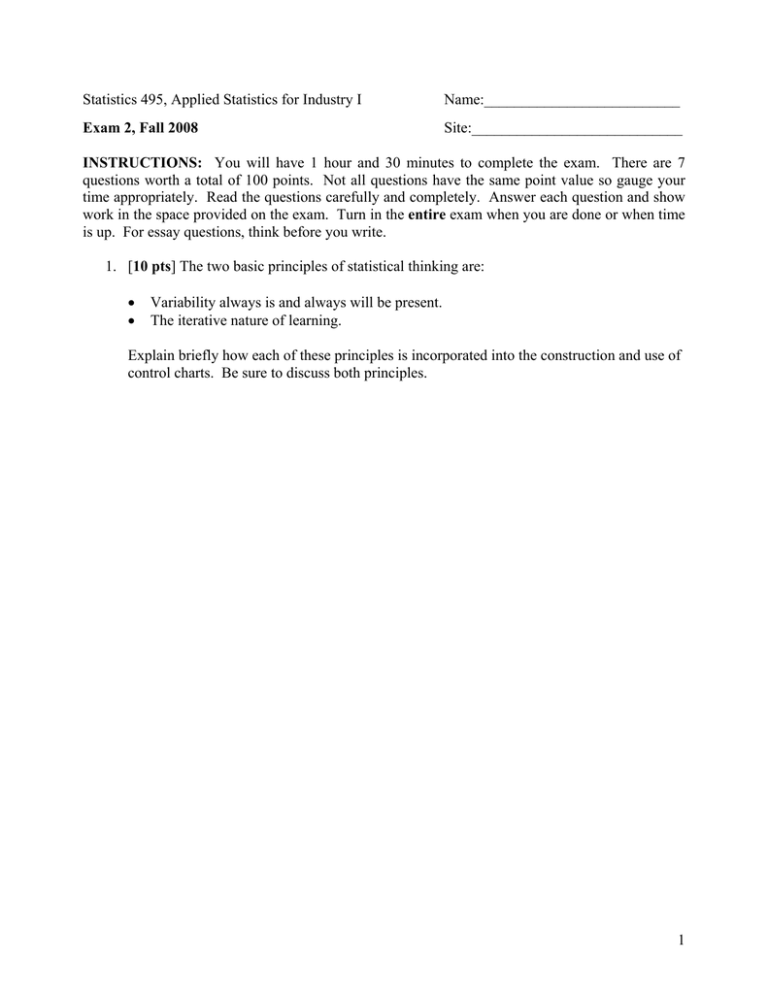
Statistics 495, Applied Statistics for Industry I Name:__________________________ Exam 2, Fall 2008 Site:____________________________ INSTRUCTIONS: You will have 1 hour and 30 minutes to complete the exam. There are 7 questions worth a total of 100 points. Not all questions have the same point value so gauge your time appropriately. Read the questions carefully and completely. Answer each question and show work in the space provided on the exam. Turn in the entire exam when you are done or when time is up. For essay questions, think before you write. 1. [10 pts] The two basic principles of statistical thinking are: • • Variability always is and always will be present. The iterative nature of learning. Explain briefly how each of these principles is incorporated into the construction and use of control charts. Be sure to discuss both principles. 1 2. [15 pts] Two assembly lines making the same item are monitored, one with an X chart and s chart combination and the other with an X chart and R chart combination. The first assembly line has X =108.4 and s =2.21 based on subgroups of size 4. The second assembly line has X =109.2 and R =4.19 based on subgroups of size 5. a. [5] Which assembly line exhibits more consistency (less spread)? Support your answer statistically. b. [5] Calculate the control limits for the X chart for assembly line 1. c. [5] Calculate the control limits for the X chart for assembly line 2. 2 3. [25 pts] Ceramic boards for classrooms are produced in 4 foot by 8 foot sheets. The production manager is concerned about surface defects on the sheets. Below are the data. Day Number 1 2 3 4 5 6 7 8 9 10 11 12 13 14 Number of Boards 1 5 2 3 2 2 3 1 1 3 4 3 3 4 Number of Defects 2 5 3 8 1 4 8 0 2 8 5 7 4 6 Day Number 15 16 17 18 19 20 21 22 23 24 25 26 27 28 Totals Number of Boards 6 3 5 4 7 3 4 2 5 2 2 1 2 3 86 Number of Defects 18 6 8 17 4 6 4 5 2 5 0 15 3 5 161 a. [3] Compute the average number of defects per day. b. [5] Calculate the upper control limit (UCL) and lower control limit (LCL) for a cChart for the number of defects. Put these limits, along with the center line, on the run chart on the next page. 3 C Control Chart Count for Number of Defects 20 15 10 5 0 0 5 10 15 20 25 30 Sample c. [3] Are there any days that plot outside the control limits? If so, what days are they and how many defects are there on those days? d. [3] Another way to chart this data is with a U-Chart for the rate of defects per board. Compute the average rate of defects per board. e. [4] Because of the unequal number of boards inspected each day, the U-Chart will have different limits for each day. Compute the upper and lower control limit for day 15. 4 f. [3] Looking at the U-Chart of surface defects on ceramic boards, are there any days that plot outside the control limits? If so, what days are they and what is the rate of defects on each of those days? U Control Chart Count Per Unit for Number of Defects 20 15 10 5 UCL 0 LCL 0 5 10 15 20 25 30 Sample g. [4] Which chart, the c-Chart or the U-Chart gives a more accurate picture of the process that is producing the ceramic boards? Explain briefly. 5 4. [10 pts] For the following, assume that we have an idealized process that produces items with a measured quality characteristic that is normally distributed with process center μ and process standard deviation σ . a. [4] For an X chart with alarm rule of a single point outside 3 “sigma” control limits, the ARL for the on target, in control process is 385. Suppose we wanted an on target, in control process to have an ARL of 250, where should the control limits be set? b. [6]} For an X chart with alarm rule of a single point outside 2.6 “sigma” control limits, the ARL for the on target, in control process is about 100. What subgroup size should we take so that a 0.4 σ shift from center will be detected within 15 subgroups, on average? 6 5. [15 pts] A rental car agency wants to improve the quality of the services they provide at an airport. For each of the following situations indicate what type of control chart should be constructed to monitor the quality characteristic of interest. Briefly explain your choice. a. [5] The number of people riding the rental agency’s shuttle buses each day. b. [5] The time it takes each customer from the moment she/he steps off the shuttle bus till she/he exits the agency in a rental car. c. [5] The number of vehicle rental contracts, each day, where the collision damage coverage is declined. 7 6. [20 pts] An important step of an aerosol manufacturing process is the filling of the aerosol cans. The fill weights (in grams) of aerosol cans are recorded for forty subgroups of five aerosol cans. Variables control charts are produced for the forty subgroups. a. [3] Below is the R chart for the forty subgroups. Using the one point out of control limits alarm rule, are there any subgroups that plot out of control? If so, what subgroups are they? R Chart Range of Aerosol Fill Weight 6 5 4 UCL=3.47 3 2 Avg=1.64 1 0 LCL=0.00 -1 0 5 10 15 20 25 30 35 40 Sample b. [3] What does this tell you about the aerosol can filling process? c. [4] If the subgroups you identified in a) were removed, how would the center line and control limits on the R chart change. You do not have to calculate the new center line or control limits simply tell me how they would change and explain your reasoning. 8 d. [10] Our operational definition of “in control” for the X chart is passing Tests 1, 2, 5 and 6. Refer to the X chart below. Indicate if the X chart passes each test. If it does not pass a test indicate every subgroup where the test fails. X Chart Mean of Aerosol Fill Weight 114.0 113.5 113.0 112.5 UCL=112.268 A B C C B A 112.0 111.5 111.0 110.5 Avg=111.323 LCL=110.377 110.0 0 5 10 15 20 25 30 35 40 Sample • Test 1: One point beyond Zone A • Test 2: Nine points in a row in Zone C or beyond, on one side of center. • Test 5: Two out of three points in a row in Zone A or beyond, on one side of center. • Test 6: Four out of five points in a row in Zone B or beyond, on one side of center. 9 7. [5 pts] Consider a hypothetical process that is producing defects at a rate of 4 per hour. A theoretical c chart for the number of defects per hour has control limits given by: LCL = 0.0 UCL = 4 + 3 4 If the process changed so that it started producing defects at a rate of c=9 per hour, what is the average run length, ARL, before the c chart would detect the change? Hint: Compute the approximate probability that, after the change, there would be a number of defects in a given hour that is beyond the UCL given above. Recall that the number of defects per hour is approximately normally distributed with mean = c and standard deviation = c . 10


